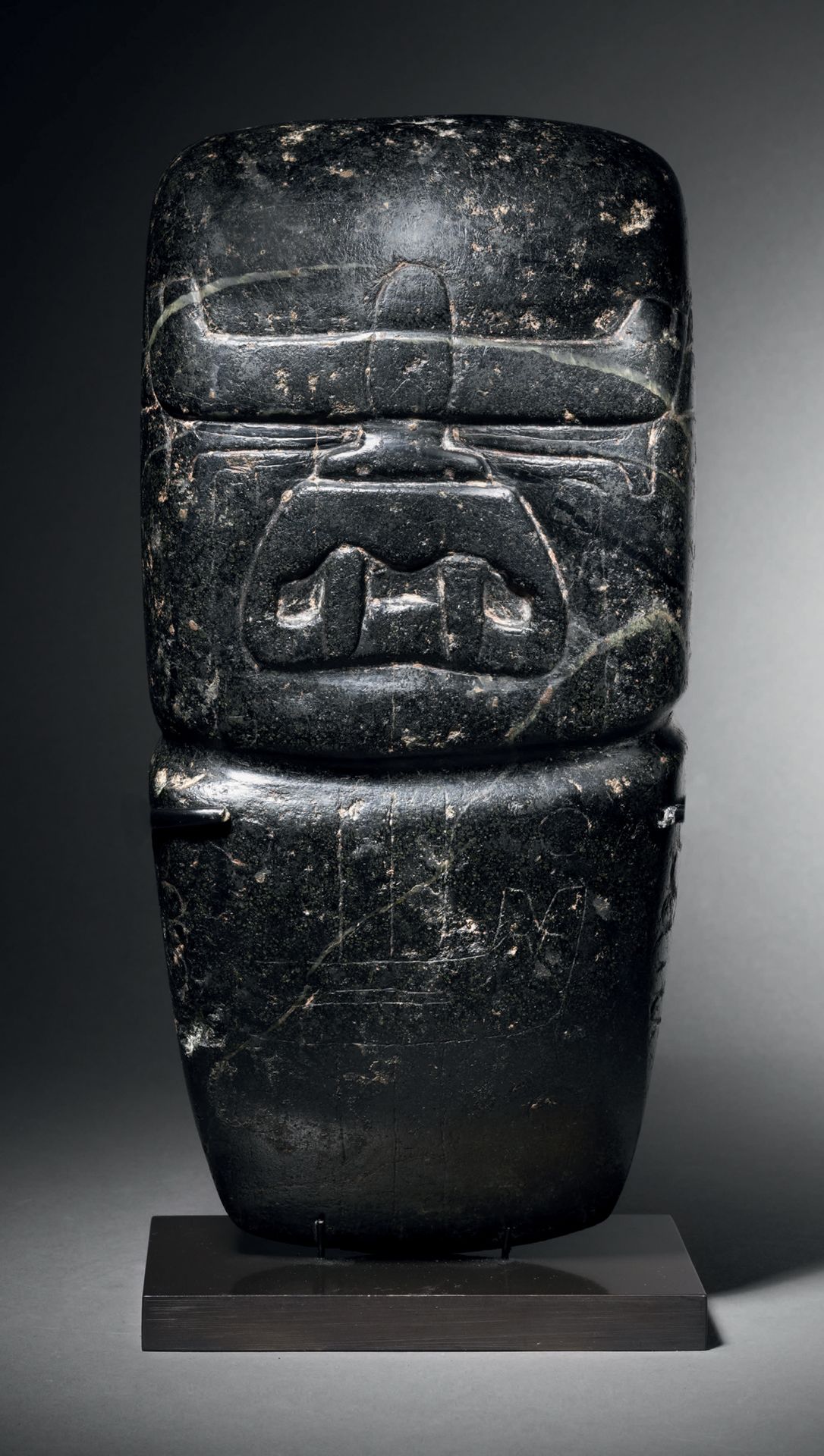Description
HACHE VOTIVE aux traits du WERE-JAGUAR Culture Olmèque, Mexique Préclassique moyen, 900-400 avant J.-C. Serpentine vert foncé veiné vert clair H. 27 cm Olmec votive axe with “Were-Jaguar” features, dark green serpentine with lighter green veins, Mexico H. 10 5/8 in Provenance : Acquis par l'actuel propriétaire en 2003 Marisol Stokes, Nyack, acquis par héritage en 1989 D'après un affidavit notarié, cet objet faisait partie de la collection d'art Olmèque de Mr. John A. Stokes le 6 octobre 1974 Ancienne collection John A. Stokes, Nyack, USA Raul Kamffer, Mexico City, acquis en 1961 Publications : Coe, Michael D. et al., The Olmec World - Ritual and Rulership, The Art Museum, Princeton University in association with Harry N. Abrams Inc., New York, 1995, p.203-204, fig. 93. Pang, Hildegard Delgado, Pre-Columbian Art - Investigations and Insights, University of Oklahoma Press, Norman, 1992, p. 30, fig. 1.4b.o (dessin). Joralemon, Peter David, “The Olmec Dragon: A Study in Pre-Columbian Iconography", in Origins of Religious Art and Iconography in Preclassic Mesoamerica, Henry B. Nicholson, (éd.), Los Angeles, 1976, fig. 12-e et fig.19-o (dessins) (Publié à la suite d'une conférence "Origins of Religious Art and Iconography in Preclassic Mesoamerica" tenue à l'université UCLA, les 25 et 26 février 1973). Wicke, Charles R., Olmec: An Early Art Style of Precolumbian Mexico, University of Arizona Press, Tucson, 1971, p. 133, fig. 34-o (dessin). Expositions : The Olmec World: Ritual and Rulership The Art Museum, Princeton University, 16 décembre 1995 - 25 février 1996 The Museum of Fine Arts, Houston, 14 avril - 9 juin 1996
39
HACHE VOTIVE aux traits du WERE-JAGUAR Culture Olmèque, Mexique Préclassique moyen, 900-400 avant J.-C. Serpentine vert foncé veiné vert clair H. 27 cm Olmec votive axe with “Were-Jaguar” features, dark green serpentine with lighter green veins, Mexico H. 10 5/8 in Provenance : Acquis par l'actuel propriétaire en 2003 Marisol Stokes, Nyack, acquis par héritage en 1989 D'après un affidavit notarié, cet objet faisait partie de la collection d'art Olmèque de Mr. John A. Stokes le 6 octobre 1974 Ancienne collection John A. Stokes, Nyack, USA Raul Kamffer, Mexico City, acquis en 1961 Publications : Coe, Michael D. et al., The Olmec World - Ritual and Rulership, The Art Museum, Princeton University in association with Harry N. Abrams Inc., New York, 1995, p.203-204, fig. 93. Pang, Hildegard Delgado, Pre-Columbian Art - Investigations and Insights, University of Oklahoma Press, Norman, 1992, p. 30, fig. 1.4b.o (dessin). Joralemon, Peter David, “The Olmec Dragon: A Study in Pre-Columbian Iconography", in Origins of Religious Art and Iconography in Preclassic Mesoamerica, Henry B. Nicholson, (éd.), Los Angeles, 1976, fig. 12-e et fig.19-o (dessins) (Publié à la suite d'une conférence "Origins of Religious Art and Iconography in Preclassic Mesoamerica" tenue à l'université UCLA, les 25 et 26 février 1973). Wicke, Charles R., Olmec: An Early Art Style of Precolumbian Mexico, University of Arizona Press, Tucson, 1971, p. 133, fig. 34-o (dessin). Expositions : The Olmec World: Ritual and Rulership The Art Museum, Princeton University, 16 décembre 1995 - 25 février 1996 The Museum of Fine Arts, Houston, 14 avril - 9 juin 1996
Vous aimerez peut-être
